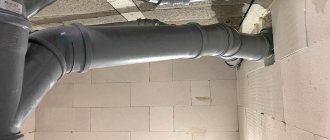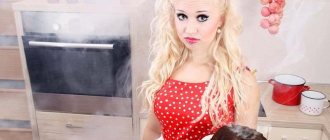The penetration of odors from sewer pipes and drains can not only complicate life in the house, but also negatively affect the health of residents.
There are several causes of sewer smell in the bathroom.
There are two main questions when there is a sewer smell in the bathroom: what are the causes and how to eliminate it. The solution to the problem may be cleaning the pipeline, adjusting ventilation, sealing joints, or re-installing the drainage system.
Causes of smell in the bathroom
The most important thing is to accurately determine the source of the unpleasant odor. In the bathroom most often it is:
- clogged sewer pipes;
- problems with the siphon . To prevent odors from the sewer from penetrating into the bathroom, a siphon holds the water plug. If you smell sewage in your bathroom, then most likely there is something wrong with the siphon. It may be installed below the sewer pipe connection. Perhaps the sewer system in the house has simply not been used for a long time, the water has dried up, giving way to unpleasant odors. Another reason is improper fixation or too long use of corrugated pipes. The siphon may simply become clogged, and deposits in it begin to decompose and emit unpleasant odors. This is usually a problem in the kitchen, but it can happen in the bathroom too;
- visible and invisible leaks . Often occur at pipe junctions. At first, literally drops of water may leak out, which will be absorbed into the finishing materials, causing the appearance of mold (where there was none before) and odor;
- poor ventilation . Perhaps the general house ventilation system is clogged, or the problem is at the junction of the individual part of the ventilation with the general one. If the air from the bathroom is not properly removed, the smell will soon be very unpleasant;
- insufficient slope of sewer pipes, as a result of which wastewater stagnates;
- high pressure in the sewer caused by blockages, small diameter channels, icing. The result is that air bubbles pass through the siphon, and with them an unpleasant odor;
- dampness _ We noticed that a damp towel left in the bathroom hardly dries, and then begins to emit an unpleasant odor. Moreover, dampness and warmth are excellent conditions for the development of mold. To reduce the level of dampness in the bathroom, eliminate leaks in taps and mixers, install a border between the bathtub and the wall to prevent water from accumulating there, prevent the cistern from leaking, and dry wet towels and bathrobes on a heated towel rail or outside the bathroom;
- dirty laundry in the washing machine is the most common and easily detected source of odor.
The worst thing is the incorrect installation of sewer pipes specifically in your bathroom. Then you will need a complete replacement of the entire system. In most cases, it is possible to escape with little blood and easily get rid of the smell, however, in each specific case the principle of action will be different.
Why is sewer smell dangerous in the bathroom? A spoiled mood is the tip of the iceberg. Towels soaked in a disgusting smell are not so bad either. But inhalation of methane, hydrogen sulfide, ammonia and other compounds can provoke insomnia, anxiety, irritability and even hypoxia, bronchitis, and vapor poisoning.
Harm to health
Many people don’t even think about the harm this can cause. Everyone knows that water and waste flow through sewer pipes. The common house pipeline is connected to the city system, which transports wastewater to processing stations - wastewater treatment plants.
When a blockage occurs and, as a result, fluid stagnation, harmful fumes of hydrogen sulfide and its derivatives begin to be released into the room: nitrogen, carboxylic acids, methane and much more. A long stay in a house with such unpleasant “guests” is fraught with severe headaches, hypoxia and even asphyxia. Young children and people with high blood pressure are especially sensitive to them.
Removing sewer clogs
All plumbing fixtures are checked one by one with a powerful jet of water.
If somewhere the water is reluctant to drain, then we are dealing with a blockage, which can give off unpleasant odors. Although clogs are usually obvious when using your plumbing fixtures on a daily basis. deal with sewer blockages in the following ways:
- mechanical cleaning. This is a well-known plunger that will help with minor blockages and if the contamination is located close to the drain. For more complex cases, a plumbing cable , which is inserted into the pipe with rotational movements, reaching the blockage and removing it, and then rinsing everything with hot water. If the pipe has a complex shape, then it is almost impossible to cope;
- simple folk remedies for small blockages: pour half a pack of soda or salt into the drain, and after 20-30 minutes rinse it with hot water;
- half a glass of soda is poured into the drain, then a glass of vinegar is poured. The drain is covered with a cloth or stopper. After 30 minutes, the pipe is washed with boiling water;
- soda and citric acid are a famous duet that, once in the drain, begins to hiss and form foam. When the reaction stops, hot water is poured into the pipe;
- undiluted white is poured into the drain for 20 minutes, then washed with hot water;
How to identify the problem
First, they find the source of the odor on their own, without involving a specialist.
- If the smell comes from the siphon of the shower stall, deal with the blockage, clean the elbow, sometimes this is enough to get rid of the stench.
- If the smell penetrates into the washing machine, provide a drain so as not to connect the hose to the sewer system. In this case, use a plastic device to hang it on the edge of the toilet or bathtub. In this position, the inner drum is ventilated.
- Check the slope of visible sections of sewer pipes and compliance with the standard diameter.
- Determine the joints where the tightness is broken. For example, a joint splits when draining hot water, the gasket is worn out, and needs replacement.
After checking all possible causes of the odor, the defect is corrected. If it doesn’t help, you need to contact a specialist. Perhaps the reason is not in the apartment, but in the house sewer system.
Normalization of ventilation
After blockages, poor ventilation is the second reason for the appearance of unpleasant odors in the bathroom. to check the presence of draft : bring the flame of a candle, lighter or match to the ventilation grille, and if it remains vertical and does not lean towards the ventilation hole, then things are bad.
Why ventilation does not work well:
- large debris entered the canal;
- the neighbors have forced ventilation;
- The bathroom has doors that do not let air flow through.
Large debris can be found by shining a flashlight into the vent. If there is something like a piece of brick lying there, then it is worth removing it. It doesn’t hurt to clean the walls of the shaft from dirt with a brush, and then remove the remaining dust with a vacuum cleaner without an attachment. After this, the grille is put back in place and the traction is checked again. Often such a simple set of measures can significantly improve the quality of ventilation in the bathroom. The door, especially in the summer, should be left ajar at least sometimes.
If everything is fine with the draft, then ventilation can be improved by installing a decorative grille at the bottom of the door, but this option is not acceptable for everyone. The most effective and at the same time the most expensive method is to install a fan in the ventilation duct to provide forced ventilation.
Washing machine
Sometimes an unpleasant odor begins to penetrate into the room through the drum of the washing machine or the basket in which the laundry is folded. The smell from the car, as a rule, begins to spread if the drain hose is cut below the water seal.
Well, the laundry basket will smell unpleasant if household members start putting damp things there. Mold may begin to grow on wet clothes.
Solution
To remove the smell coming from the washing machine, you need to check the level of the drain connection. If it is inserted incorrectly, you need to correct the error. In addition, experts do not recommend keeping the car hatch tightly closed.
Siphon cleaning
The siphon under the sink, bathtub or shower is a good place for bacteria to grow.
Hair, particles of cosmetics, and fat settle in it, and then cool and literally stick to the walls. This is an excellent environment for the growth of bacteria, and gradually the mass of sewage only becomes larger, causing not only an unpleasant odor, but also complicating the outflow of wastewater. If the cause of the unpleasant odor lies precisely in the siphon, then the procedure will be as follows:
- remove the siphon and clean it of adhering deposits. It is appropriate to place a basin or bucket under the siphon so as not to stain anything;
- wash the siphon walls with dishwashing detergent;
- install a clean siphon in place, ensuring the tightness of all joints;
- Use drain cleaners regularly to prevent sediment from accumulating there.
The siphon (hydraulic seal) takes on an important function in terms of protection against odors. Thanks to the existence of a water plug, stench simply cannot get into the apartment. Siphons come in bottle, tubular and corrugated types. The bottle type is ideal for the sink; it is easy to install. The cheapest option is a corrugated siphon.
Home methods for cleaning pipelines
If there are obstacles inside the pipeline, the water in the water seal will not be renewed, and the filling drains will begin to decompose, emitting an unpleasant odor.
In order to neutralize the blockage, certain means are used:
- Salt with soda. The method is used for preventive purposes and to perform gentle cleaning of the walls of the sewer pipe. To dissolve hair and impurities, you need to use more effective chemicals.
- Vinegar with soda. This product effectively clears away fat deposits. After pouring, after 3 hours you need to pour boiling water (1-1.5 l) into the hole. Treatment with soda can be alternated with the use of a plunger.
- Using a plumbing cable. Using this product you can remove dense blockages with large debris. The use of cables in corrugated joints is not recommended, because a sharp nozzle can damage the walls.
- Use of chemicals. To remove blockages, they use certain products: Tornado, Bagi Potchan and Mr. Muscle, Chirton powder, liquid Mole, DEBOUCHER Active and Synergetic, Sanfor, Chistin, Tiret and Sanox gels.
To ensure thorough cleaning, remove the corrugation and disassemble the siphon. By reviving the pipeline you can get rid of grease, dirt, and organic waste.
In order to prevent the appearance of stench, it is necessary to monitor the condition of the sewerage system. Any owner can take protective measures to eliminate the possibility of an unpleasant odor. What do we have to do:
- place mesh in the drain holes to filter out large particles;
- clean the pipes approximately once every month and a half using mechanical or chemical methods;
- in multi-storey buildings, it is necessary to regularly assess the condition of the ventilation system (every six months, carry out a study of the ventilation shaft).
Ensuring the right amount of water in the siphon
From the above it follows that if there is not enough water in the siphon, an unpleasant aroma can spread throughout the bathroom.
It only takes a short period of time for all the water in the sink's water seal to dry out - you just don't use the sewer for a couple of weeks, and an unpleasant surprise awaits you when you return from vacation. Fortunately, this problem can be easily solved - just turn on the water, a water plug will form in the siphon again, and the smell will soon disappear. Popular wisdom suggests several ways to prevent the evaporation of water from the siphon. Before leaving, you can close the drain with a rubber stopper . Some people advise pouring sunflower oil into the drain, and upon returning, rinse the drain with an alkaline solution and plenty of hot water, but this seems too radical.
The water may not dry out completely - there just may not be enough of it. This problem is related to the shape of the siphon and is typical for S-shaped corrugated siphons. In this case, it is enough to simply install a few clamps to give the pipe the correct S-shape.
The most unpleasant option is when water from the siphon is forcibly sucked into the sewer, which is accompanied by characteristic bubbling sounds. This is usually the fault of neighbors who interfered with the sewer system of an apartment building and removed the drain pipe leading to the roof. The situation can only be corrected by reinstalling the drain pipe or choosing a high-quality aerator.
Operating principle of a fan pipe
All liquids in the sewer move by gravity. This means that the only driving force is gravity. If there is no hole in the vertical riser for air to pass through, the liquid will not flow down and will stop. To eliminate this situation, all risers have access to the roof and are open at the top. The outer part located on the roof surface is called an aerator. It ensures the removal of biogas and ventilation of the system. The incoming air does not allow the water to stop under the influence of its own elasticity. In addition, a hole in the top allows sewer gases to escape.
The section of the riser that faces the roof is called the fan pipe. The quality of operation of the entire riser and branches to apartments in a high-rise building or private house largely depends on its condition. If the drain pipe is clogged or blocked, the operation of the system is at risk of blockages that contribute to the accumulation of harmful gases.
The autonomous sewage system of a private house, the main element of which is a septic tank, also requires a drain pipe. During the process of settling and processing wastewater in tanks, a large amount of gases is released, which is removed through aerators on the tanks themselves and on the roof of the house.
Correct installation of the bottle siphon
The design of a bottle siphon is quite simple, and installing it is not very difficult, but still a common mistake occurs when the vertical pipe is higher than the water level.
In this case, the smell from the sewer freely seeps into the bathroom. The way out of the situation is to install the siphon correctly. If you come across a design where the immersion level of the pipe can be adjusted, then solving the problem will be somewhat easier.
Restoring the tightness of the sewer system
Cracks, punctures, ruptures and other defects may form on the siphon, pipes, and joints that impair the tightness of the sewer system. These places allow unpleasant odors to penetrate into the bathroom, and water also leaks through them, which sooner or later will also make itself felt with a characteristic aroma. The procedure for this case is as follows:
- thorough inspection and leak detection. Run hot water down the drain and inspect the pipes with a flashlight. You can use napkins or toilet paper - they will get wet upon contact with the problem area;
- if a defect is found on a non-separable element, it needs to be replaced. Poor quality pipes are often to blame;
- if water seeps through the joint between different elements, then first you can try tightening the connection or replacing the sealing gasket. You can also try sealing the joint with FUM tape;
- As a preventative measure, make it a rule to use silicone when installing all gaskets.
Minimizing joints in pipes
Joints are not only the weakest element in terms of leaks, but also a place where dirt and plaque easily accumulate, and where the characteristic smell is not far away. Often a huge number of joints are made when connecting the bathtub to the sewer. Unfortunately, it is only possible to properly detect and remove dirt from the joints by disassembling the drain. Chemical pipe cleaners will give a temporary and not the best effect.
If possible, try to reduce the number of joints as much as possible.
Elimination of sagging drain pipe
We are talking about the bathroom. They try to position it so that the drain hole is closer to the sewer outlet. It happens that you have to position the bath differently, and a long pipe connects the drain and sewer. If it is not made of the highest quality material, then over time it may begin to sag, water stagnates in this place, and since it contains a lot of fat and skin residues, bacteria immediately settle in this environment and begin to emit unpleasant odors.
If you look under the bathtub, you can determine the sagging by eye. If there is one, then it is enough to install a support under it to ensure a slight slope towards the sewer along the entire length of the drain. The minimum slope is 3 cm per linear meter, and preferably more.
Construction of the drainage system
The components of the sewer system include:
- pipes of various diameters necessary to drain water from the bathroom;
- ventilation and sewage risers;
- pressure manifold;
- water drainage lines.
Not only the bathroom, but also the shower room is connected to the system in a private house. The lowest point of the system is the wastewater outlet. A ventilation valve is installed on the top. This point is located above all water intake nodes. The functions of the valve include sealing the system so as not to allow harmful gases and odors to enter the room.
All outlets of the system into the collector are connected to the lower point ending with the siphon. This includes a bathroom and shower. All pipes must slope towards the collector well. An ideal sewer system does not have sharp turns of 90 degrees, and there are no changes in height within one branch.
Mold control
A humid, warm environment, lots of wet towels and gowns, and problems with ventilation are ideal conditions for mold to grow.
If you have ever heard this unpleasant smell, then you understand what we are talking about. Not only does it become difficult to be in the bathroom, but also inhaling such air is very dangerous. Particularly dangerous is black mold, which can affect any surface and ultimately lead to insomnia, dermatitis, asthma, pneumonia and even lung cancer. There are many ways to combat mold:
- ready-made special products are the most reliable option. Modern fungicides do an excellent job even with black mold, but when the mold has been overcome, it is better to periodically treat it with antiseptic agents for preventive purposes. Ideally, clean off all mold-affected layers of finishing, since the mycelium takes its roots very deep;
- Bleach is a worthy replacement for special products. It is diluted with water in a ratio of 1:10, then the whole thing is applied with a brush to the affected area;
- vinegar can also be sprayed onto the affected area and washed off with a damp cloth after a while;
- peroxide is poisonous to mold, but be careful - it will discolour painted surfaces. A 3% peroxide solution is applied directly to the damaged area;
- ammonia is mixed with water in a 1:1 ratio. Works effectively on hard, non-porous surfaces. Do not mix with bleach;
- borax (1 glass) is diluted in water (2.5 l), and the solution is applied with a stiff brush;
- also use tea tree oil, lavender and rosemary oil, potassium permanganate, soda, and citric acid. The smell of mold can remain even after it is removed, and you can eliminate it with baking soda. It is left in the place where the fungus lived, and then collected with a vacuum cleaner.
Means for eliminating unpleasant odors
A qualified plumber will help repair damaged elements of the water supply system, who will carry out the necessary measures to clean, replace and restore the tightness of the installation.
If the sink or bathtub smells due to a clog, storing professional tools or proven folk methods will help.
Household chemicals for removing blockages
Store-bought products will help you clear clogs in minutes. Thanks to their acidic or alkaline composition, they quickly dissolve fats, biological contaminants and food residues.
Table 1. Tools for unloading sewers.
| Name | Volume, ml | price, rub. |
| Mr. Muscle | 500 | 199 |
| Domestos | 500 | 370 |
| "Anti-clogging" | 500 | 99 |
| "Chistin" | 500 | 47 |
| Tiret | 500 | 319 |
| "Mole" | 1000 | 109 |
| Sanfor | 750 | 119 |
| Rorax Power Gel | 1000 | 349 |
Important: When choosing a clog remover, consider the type of pipe plug so as not to damage it.
Traditional methods of dealing with blockages
To solve the problem yourself, what to do if the sink stinks, you need to arm yourself with a long cable with a cleaning agent, a plunger, as well as simple products available in every home.
- Baking soda easily removes the oily layer on the inside of the drain. Fill the drain hole with a glass of powder, wait about an hour, and rinse the installation with boiling water.
- Coarse salt – works similarly to baking soda. Pour into a glass, add a glass of boiling water. After 2-3 hours, rinse the drain with hot running water.
- If the water does not stand still, but goes away a little, you can rinse the drain with dishwashing gel or regular powder. Place them in the system, wait a minute, press in the hot water plug, helping yourself with the plunger.
- Pour a glass of lemon juice or diluted citric acid into the tube for 2 hours, it will soften solid food residues and remove the unpleasant odor for a long time.
- Soda + vinegar. The most effective remedy, including preventative, is: pour a glass of baking soda, pour ½ glass of vinegar. The mixture will react violently, clog, and the smell will disappear.
Prevention of odor
In most cases, solving the problem of unpleasant odor in the bathroom is indeed not difficult, but it is even easier to never encounter such a problem, so it is still worth knowing about some preventive measures:
- simple mesh filters on the drain holes trap a huge amount of dirt, preventing rapid clogging of the sewer and the appearance of aroma;
- to clean pipes with special means once every couple of months, without waiting for a serious problem. Plaque still remains on the pipes, and it is important to “wash it off” in time, since other contaminants stick to it well;
- It is generally better to remove debris and grease from the siphon once a month;
- The draft in the ventilation duct should be checked twice a year;
- make it a rule to regularly inspect the joints of sewer pipes;
- Before leaving, cover the drain holes with a lid;
- do not forget to wash the toilet seat mounts . It is necessary to remove all elements and carefully wipe under the fasteners. These are the places where the most dirt collects. In the future, you should occasionally wipe under the seat with a brush to prevent odor;
- Use lemon cleaner to clean surfaces. It is important to buy quality substances; you should not skimp on such products;
- To fill your bath with a pleasant aroma, you can make your own air freshener . You will need a diffuser with essential oil, water and witch hazel. For a more lasting aroma, it is worth adding a few drops of peppermint oil to the solution;
- To bring a pleasant smell into the bathroom, you can make washers from essential oil and soda . Mix half a cup of baking soda and a few drops of essential oil. You should get a paste of medium thickness. Can be poured into muffin tins. We put the washers on shelves in the bathroom, a basket for dirty laundry and use them as an air freshener;
- If towels are constantly in the bathroom , wash them with the addition of vinegar. Instead of conditioner, add half a cup of purified vinegar and wash at high temperature. Then you should dry the laundry in the fresh air;
- even if the ventilation is fine, sometimes leave the door open to reduce the humidity in the bathroom.
If possible, dry towels and bathrobes on a heated towel rail or on the balcony. Do not leave dirty laundry in the washing machine or a special bucket for too long, and in general, try to clean all surfaces in the bathroom regularly. If you are too lazy to do this yourself, you can always hire a contractor to enjoy cleanliness and pleasant aromas in the bathroom.
The article was written for the site.
Tags:Bathroom, lifehack, Cleaning
Why is ambre from the drain dangerous?
The composition of sewage water is rich in ammonia, hydrogen sulfide, methane and other substances that are formed during the decomposition of organic matter. Many of these compounds evaporate and enter the human respiratory tract with the air.
Most gases are poisonous and, if continuously inhaled, cause serious health problems for residents:
anxiety, nervousness;- irritable behavior;
- sleep disturbance;
- rhinitis;
- bronchitis;
- nausea, vomiting;
- migraine;
- dizziness;
- pressure disturbance;
- blurred vision.
Prolonged exposure to persistent sewer vapors can lead to general intoxication and illnesses requiring medical intervention.











